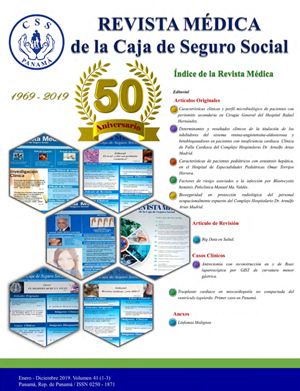CLINICAL FEATURES AND MICROBIOLOGICAL PROFILE OF PATIENTS WITH SECONDARY PERITONITIS IN GENERAL SURGERY HOSPITAL RAFAEL HERNÁNDEZ. DAVID, CHIRIQUI. YEARS 2017 AND 2018.
Main Article Content
Abstract
Background: Secondary peritonitis is a common cause of morbidity worldwide with a prevalence of up to 8.6% with a mortality of 20-60%.
Objectives: Describe clinical characteristics and microbiological profile of patients with secondary peritonitis in general surgery at Rafael Hernández hospital. David, Chiriquí. 2017 and 2018 years.
Methods: It is an observational, descriptive and retrospective study. The universe was all the patients who were hospitalized in general surgery with surgical abdominal pathology and who have developed secondary peritonitis in the course of their hospitalization at the Rafael Hernández Hospital in the years 2017 and 2018.
Results: Peritonitis had a higher prevalence in people over 60 with 36.84%. The highest proportion was in men with 62.28%. The highest diagnosis of admission was acute abdomen with 48.25%. The most frequent etiologic agent was E. coli with 64.9%. 79.82% were infections associated with a single microorganism. The most frequent antibiotic treatment was ciprofloxacin plus metronidazole with 26.32%. There was 100% correspondence of the antibiogram with the antibiotic received in cases in which there was a positive culture. And in terms of mortality it was evidenced that it had a frequency of 15.79% of which 33% was caused by bacteria producing beta lactamase.
Discussion: The most frequent etiological agent, the diagnosis most associated with secondary peritonitis and the ages where it occurs most frequently are consistent with what is reported in the literature, in terms of sex, the male predominated
Downloads
Article Details
Issue
Section

This work is licensed under a Creative Commons Attribution-NonCommercial 4.0 International License.
How to Cite
References
1. Bennett, J. E., Dolin, R. M., & Blaser, M. J. (2016). Enfermedades infecciosas. Principios y práctica. España: Elsevier España.
2. Coccolini, F., & al, e. (2015). Antibiotic resistance pattern and clinical outcomes in acute cholecystitis: 567 consecutive worldwide patients in a prospective cohort study. International journal of surgery, 32-37.
3. Comisión estatal de derechos humanos Nuevo León. (2016, abril 19). Comisión estatal de derechos humanos Nuevo León. Retrieved from Comisión estatal de derechos humanos Nuevo León: https://www.cedhnl.org.mx/imagenes/publicaciones/presentaciones/CEDHNL_VIISeminarioDHS/ModuloIII/CausaManera-y-Mecanismo-de-Muerte-1.pdf
4. Feldman, M. M., Friedman, L. S., & Brandt, L. J. (2018). Sleisenger y Fordtran. Enfermedades digestivas y hepáticas, 10.ª edición. España: Elsevier.
5. Fernandez, C. (2001). Peritonitis Postoperatorias. Cirugía Española, 304-309.
6. González, A., & Velásquez, G. (2005). Peritonitis secundaria. Revista de investigación clínica, 706-715.
7. Jeana, S.-S., & al, e. (2014). Clinical characteristics of patients with community-acquiredcomplicated intra-abdominal infections: A prospective,multicentre, observational study. International Journal of Antimicrobial Agents, 222-228.
8. Klaus Emmanuel, M., & al, e. (2005). Current and future concepts of abdominal sepsis. World journal of surgery, 1.
9. Ordoñez, C. M., & al, e. (2006). Mortalidad y Morbilidad de la Peritonitis Secundaria con Relaparotomía Planeada. Revista Colombiana de Cirugía, 124-132.
10. Porto, J. P., & Merino, M. (2017). definicion.de. Retrieved from definicion.de: https://definicion.de/agente-etiologico/
11. Real Academia española. (2018). Real academia española. Retrieved from diccionario de la lengua española: https://dle.rae.es
12. Remigio, F. (2013, January-june). Peritonitis secundaria y factores asociados en el hospital José Carrasco Arteaga. Peritonitis secundaria y factores asociados en el hospital José Carrasco Arteaga, Cuenca, Enero a Junio de 2013. Cuenca, Cuenca, Ecuador.
13. Riché, F., & al, e. (2009). Factors associated with septic shock and mortality in generalized peritonitis: comparison between community - acquired and postoperative peritonitis. Critical Care, 1-9.
14. Sarteli, M., & Chichom-Mefire, A. (2017). The management of intraabdominal infections from a global perspective: 2017 WSES guidelines for management of intraabdominal infections. World journal of emergency surgery, 8.
15. Sciscione, A. D. (2019). Peritonitis secundary. In F. F. Ferri, Ferri’s clinical advisor (p. 1). Philadelphia, PA 19103-2899: Elsevier.
16. Seni, J., & al, e. (2016). Comparison of antimicrobial resistance patterns of ESBL and non ESBL bacterial isolates among patients with secondary peritonitis at Bugando Medical Centre, Mwanza – Tanzania. BMC Emergency medicine, 1-5.
17. Solomkin, J., & al, e. (2010). Diagnosis and Management of Complicated Intra-abdominal Infection in Adults and Children: Guidelines by the Surgical Infection Society and the Infectious Diseases Society of America. Clinical infectious diseases, 133-164.
18. Syue, L.-S., & al, e. (2016). New drugs for the treatment of complicated intra-abdominal infections in the era of increasing antimicrobial resistance. International Journal of Antimicrobial Agents, 250-258.
19. Tolonen, M., & al, e. (2016). Preoperative prognostic factors for severe diffuse secondary peritonitis: a retrospective study. Langenbecks Arch Surg, 1-7.
20. Vincent, J.-L. M., & al, e. (2017). Textbook of critical care Seventh edition. Philadelphia, PA 19103-2899: Elsevier.
21. Wenwei, O., & al, e. (2016). Clinical characteristics and antimicrobial patterns in complicatedintra-abdominal infections: a 6-year epidemiological study in southern China. International Journal of Antimicrobial Agents, 210-216.
22. Wong, P., Gillian, A., & Kumar, S. (2012). Antibiotic regimens for secundary peritonitis of gastrointestinal origin in adults (Review). The Cochrane collaboration, 2.
23. European Centre for Disease Prevention and Control. Surveillance of antimicrobial resistance in Europe – Annual report of the European Antimicrobial Resistance Surveillance Network (EARS-Net) 2017. Stockholm: ECDC; 2018.

